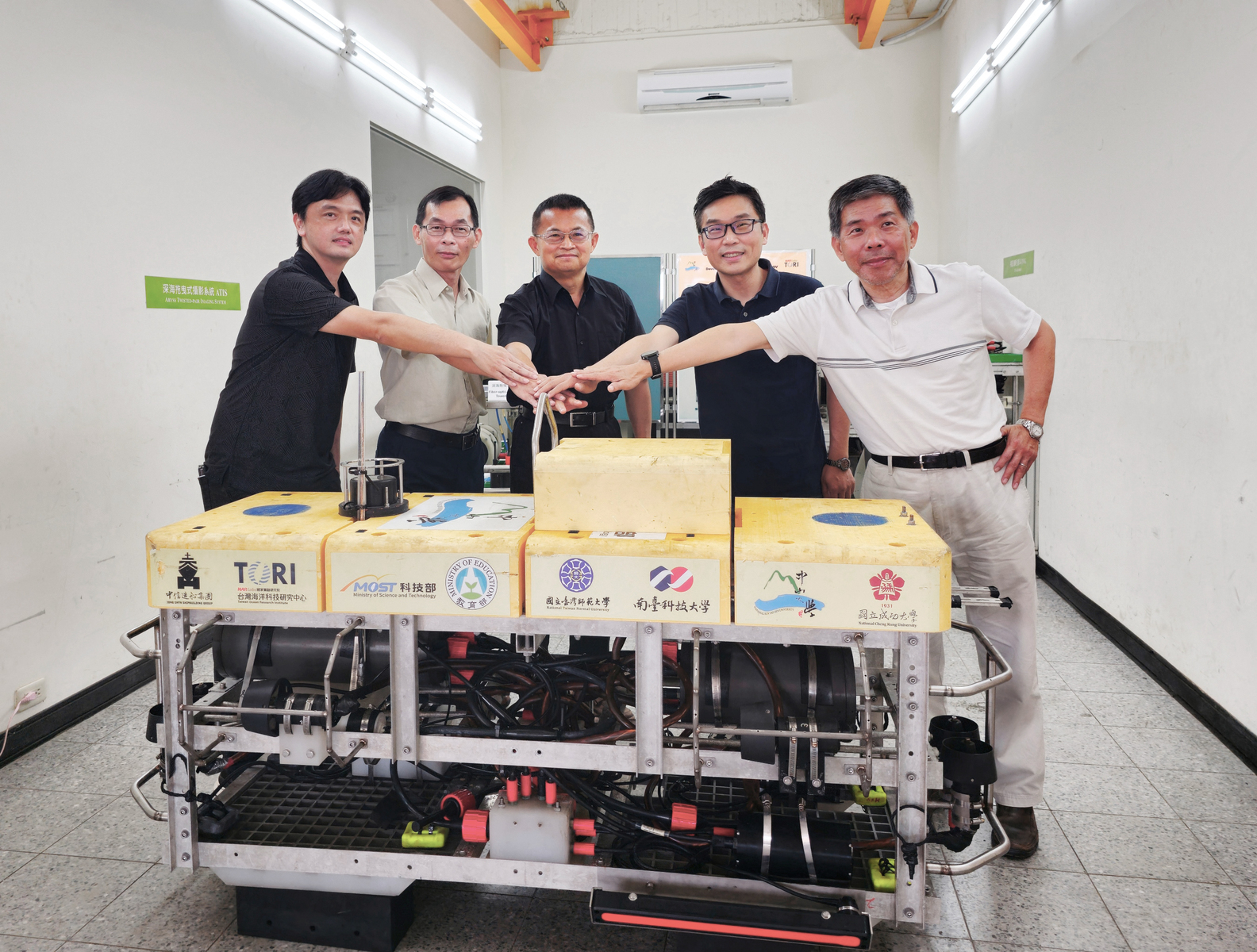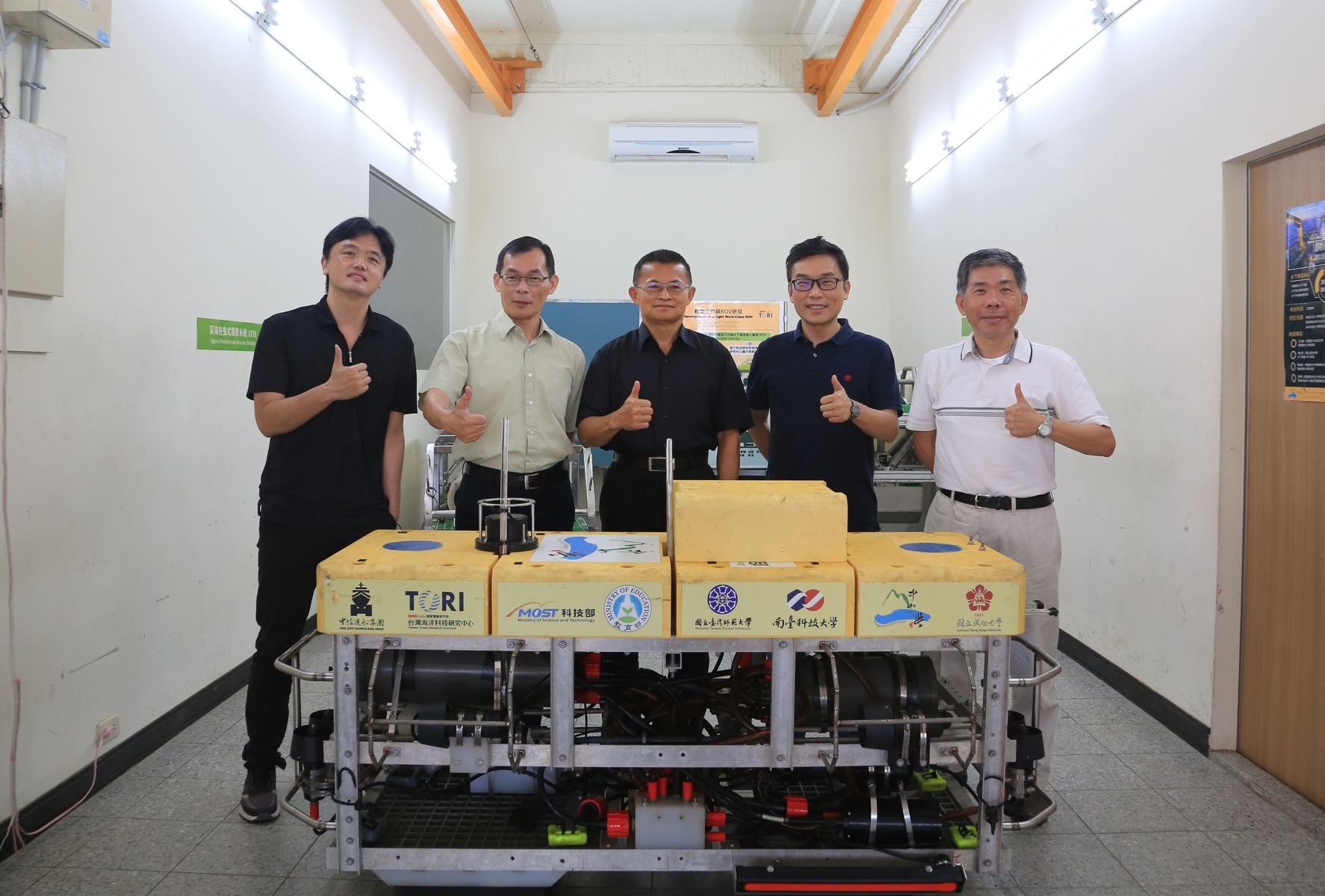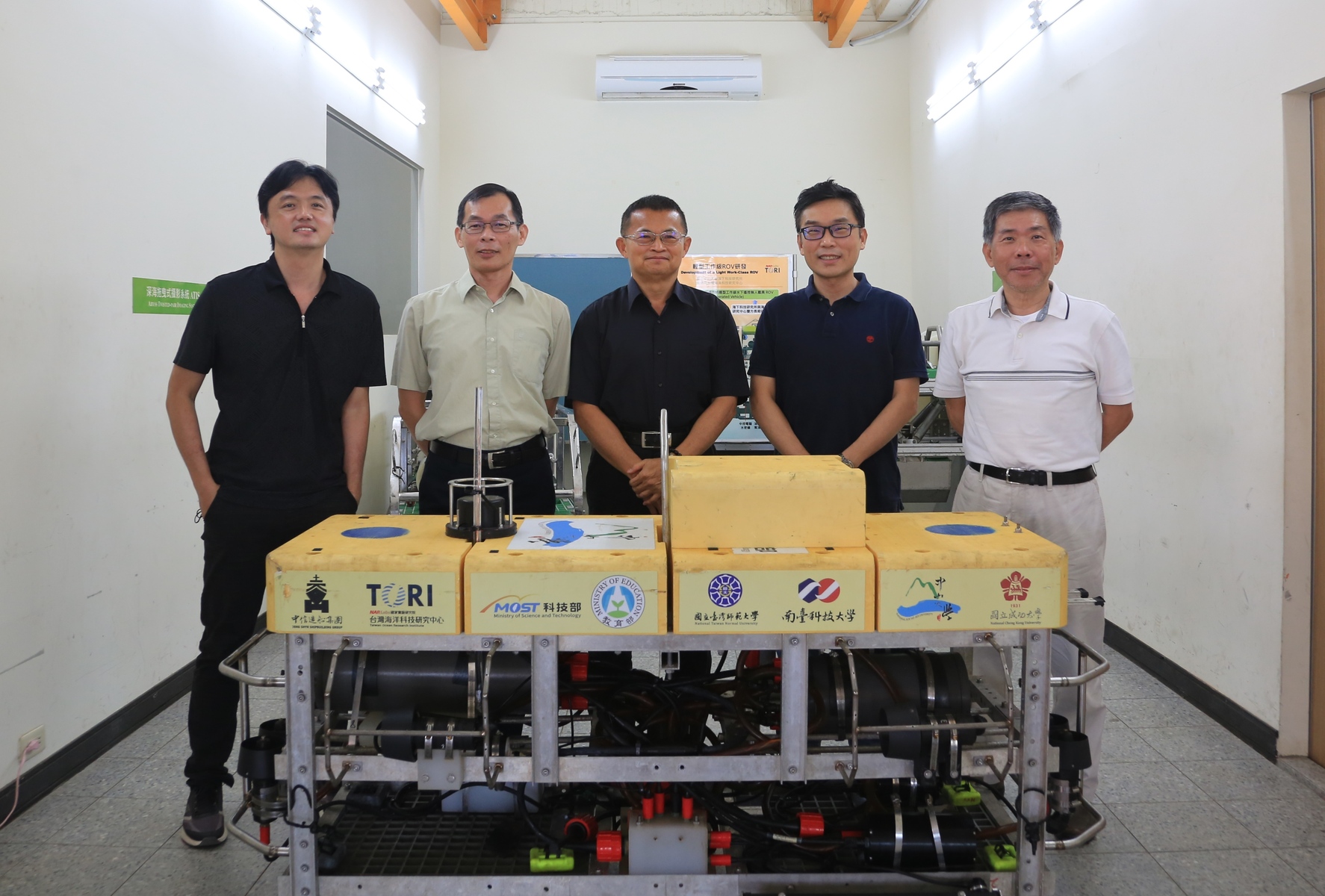NSYSU launched Taiwan's first marine-specific Autonomous Underwater Vehicle utilizing Innovative AI Technology



2023-05-30
National Sun Yat-sen University (NSYSU) announced the launch of Taiwan’s first Autonomous Underwater Vehicle (AUV) with Artificial Intelligence (AI) techniques. To explore the resources and risks under the sea, NSYSU kicked off the Key Technology Development for AUV with AI project, which is a mission-oriented project of the National Science and Technology Council’s (NSTC) Semiconductor Manufacturing & Design for AI Edge (Moonshot Project.) The AUV developed by NSYSU applied AI and Deep Learning technology along with information and communications techniques, semiconductors, and embedded systems, presenting cutting-edge technical advantages in speedy detection, abundant image information, positioning, obstacle avoidance navigation, and charging efficiency. The AUV represented a significant success of industry-academia collaboration very clearly.
Autonomous Underwater Vehicle (AUV) technology plays a critical role in areas of oceanography. The Principal Investigator, Chua-Chin Wang, Professor of the Department of Electrical Engineering and Vice President for Research and Development at NSYSU, emphasized that the environmental challenges that AUVs face are even more serious than those faced by autonomous flying vehicles (drones). In order to overcome all the obstacles, the NSYSU team developed a hardware accelerator and lightweight neural network algorithm with low-power consumption and high performance on silicon. Besides, the techniques of image dehazing, color accuracy, and LED intelligent compensation lighting are also applied in the AUV. “We successfully raised the accuracy rate of underwater object detection to higher than 80%. The detection speed is as fast as the human eye, about the capacity to recognize 20 pictures within one second,” said Professor Wang.
With innovative AI technologies applied, the AUV can assist with monitoring marine pollution, facilitating effective aquaculture and fishery, maritime biology search, ocean conservation, and rescue operations, by recognizing up to 20 different categories of underwater objects, including glass bottles, plastic bottles, tires, divers, lionfish, sea turtles, sharks, and stingrays. Moreover, the AI seabed sonar telemetry analysis system equipped therewith the AUV can analyze various kinds of seabed materials, including mud, sand, or rocks. The system can be applied in different industries, such as military submarines, offshore wind power stations, and fish finders. For example, the system can effectively track changes in the soil near the offshore pile foundation for wind turbines, which assists the development of green power industries in Taiwan.
In the testing stages, the AUV has been placed in Kaohsiung Port, Anping Port, and Liuqiu for open sea trials to verify the capability of dealing with environmental challenges, such as sediments, currents, and darkness. In addition, Professor Wang also underwent training and obtained an “Open Water Diver” license to conduct the AUV sea trials personally. The AUV’s capabilities of dehazing, obstacle avoidance, recognition, navigation, and wide-range (over 80x80 meters) cruising were confirmed clearly through those sea trials.
The limitation of battery power presents another significant challenge for both AUVs and autonomous flying vehicles. To reduce the battery power consumption of the AUVs, it is essential to allocate the majority of power for real-time recognition currently, prioritizing it over real-time machine learning. Professor Wang indicated that the team had the AUV finished machine learning before the sea trials so that most of battery power for the algorithm could be used in real-time detection, recognition, and following. Besides, to strengthen the power endurance of the AUV, the team utilized two AUV-specific fast charging techniques, including direct battery charging via water without going ashore.
The Key Technology Development for Autonomous Underwater Vehicle with Artificial Intelligence is a four-year project. During the development process of Taiwan’s first AUV utilizing AI technology, the NSYSU R&D team faced various challenges. For example, it is necessary to prepare at least ten thousand of labeled object pictures for each category to implement AI identification training. Without enough materials, researchers then utilized 3D modeling techniques to enlarge database of underwater images 100 times for AI machine learning, recognition, and optimization successfully. At the early stage, they also conducted tests on the recognition functions using stuffed shark or clownfish toys, empowering the AUV can contribute to both academic research and the preservation of marine animals.
Another challenge is the background noises underwater, which obstruct acoustic wave transmission between the mother ship and the AUV. During the first open sea trial conducted in Liuqiu, there was once a situation where the AUV failed to start after the mother ship had transmitted the activating sound signal. Afterward, the team utilized three strategies, including amplifying acoustic emission power, positioning AUV more precisely in transmission, avoiding sound wave refractions interference factors from the seabed or other ships, and the mother ship finally transmitting signals to activate the AUV within half a Nautical mile.
Accumulating years of AI R&D achievements, NSYSU took the lead in 2020 and successfully built Taiwan's first and only developed ocean-specific AUV with AI capabilities. It has made breakthroughs in AI technology innovation and can achieve object recognition, following, obstacle avoidance, and self-correction. It will further lay an independent technical foundation for Taiwan’s marine science and technology industries and contribute to different fields such as underwater detection, rescue, resource collecting, biological database, fish finding, smart aquaculture, pollution monitoring, and national security. For the next stage in 2022, Professor Wang once again led the NSYSU team to conduct a two-year (2022-2024) “Information Security Design and Simulation of Marine IoT” continuation project to deepen underwater AI research. The team will utilize AI techniques to structure the information security for networks underwater and develop more innovative applications.
National Sun Yat-sen University (NSYSU) announced the launch of Taiwan’s first Autonomous Underwater Vehicle (AUV) with Artificial Intelligence (AI) techniques. To explore the resources and risks under the sea, NSYSU kicked off the Key Technology Development for AUV with AI project, which is a mission-oriented project of the National Science and Technology Council’s (NSTC) Semiconductor Manufacturing & Design for AI Edge (Moonshot Project.) The AUV developed by NSYSU applied AI and Deep Learning technology along with information and communications techniques, semiconductors, and embedded systems, presenting cutting-edge technical advantages in speedy detection, abundant image information, positioning, obstacle avoidance navigation, and charging efficiency. The AUV represented a significant success of industry-academia collaboration very clearly.
Autonomous Underwater Vehicle (AUV) technology plays a critical role in areas of oceanography. The Principal Investigator, Chua-Chin Wang, Professor of the Department of Electrical Engineering and Vice President for Research and Development at NSYSU, emphasized that the environmental challenges that AUVs face are even more serious than those faced by autonomous flying vehicles (drones). In order to overcome all the obstacles, the NSYSU team developed a hardware accelerator and lightweight neural network algorithm with low-power consumption and high performance on silicon. Besides, the techniques of image dehazing, color accuracy, and LED intelligent compensation lighting are also applied in the AUV. “We successfully raised the accuracy rate of underwater object detection to higher than 80%. The detection speed is as fast as the human eye, about the capacity to recognize 20 pictures within one second,” said Professor Wang.
With innovative AI technologies applied, the AUV can assist with monitoring marine pollution, facilitating effective aquaculture and fishery, maritime biology search, ocean conservation, and rescue operations, by recognizing up to 20 different categories of underwater objects, including glass bottles, plastic bottles, tires, divers, lionfish, sea turtles, sharks, and stingrays. Moreover, the AI seabed sonar telemetry analysis system equipped therewith the AUV can analyze various kinds of seabed materials, including mud, sand, or rocks. The system can be applied in different industries, such as military submarines, offshore wind power stations, and fish finders. For example, the system can effectively track changes in the soil near the offshore pile foundation for wind turbines, which assists the development of green power industries in Taiwan.
In the testing stages, the AUV has been placed in Kaohsiung Port, Anping Port, and Liuqiu for open sea trials to verify the capability of dealing with environmental challenges, such as sediments, currents, and darkness. In addition, Professor Wang also underwent training and obtained an “Open Water Diver” license to conduct the AUV sea trials personally. The AUV’s capabilities of dehazing, obstacle avoidance, recognition, navigation, and wide-range (over 80x80 meters) cruising were confirmed clearly through those sea trials.
The limitation of battery power presents another significant challenge for both AUVs and autonomous flying vehicles. To reduce the battery power consumption of the AUVs, it is essential to allocate the majority of power for real-time recognition currently, prioritizing it over real-time machine learning. Professor Wang indicated that the team had the AUV finished machine learning before the sea trials so that most of battery power for the algorithm could be used in real-time detection, recognition, and following. Besides, to strengthen the power endurance of the AUV, the team utilized two AUV-specific fast charging techniques, including direct battery charging via water without going ashore.
The Key Technology Development for Autonomous Underwater Vehicle with Artificial Intelligence is a four-year project. During the development process of Taiwan’s first AUV utilizing AI technology, the NSYSU R&D team faced various challenges. For example, it is necessary to prepare at least ten thousand of labeled object pictures for each category to implement AI identification training. Without enough materials, researchers then utilized 3D modeling techniques to enlarge database of underwater images 100 times for AI machine learning, recognition, and optimization successfully. At the early stage, they also conducted tests on the recognition functions using stuffed shark or clownfish toys, empowering the AUV can contribute to both academic research and the preservation of marine animals.
Another challenge is the background noises underwater, which obstruct acoustic wave transmission between the mother ship and the AUV. During the first open sea trial conducted in Liuqiu, there was once a situation where the AUV failed to start after the mother ship had transmitted the activating sound signal. Afterward, the team utilized three strategies, including amplifying acoustic emission power, positioning AUV more precisely in transmission, avoiding sound wave refractions interference factors from the seabed or other ships, and the mother ship finally transmitting signals to activate the AUV within half a Nautical mile.
Accumulating years of AI R&D achievements, NSYSU took the lead in 2020 and successfully built Taiwan's first and only developed ocean-specific AUV with AI capabilities. It has made breakthroughs in AI technology innovation and can achieve object recognition, following, obstacle avoidance, and self-correction. It will further lay an independent technical foundation for Taiwan’s marine science and technology industries and contribute to different fields such as underwater detection, rescue, resource collecting, biological database, fish finding, smart aquaculture, pollution monitoring, and national security. For the next stage in 2022, Professor Wang once again led the NSYSU team to conduct a two-year (2022-2024) “Information Security Design and Simulation of Marine IoT” continuation project to deepen underwater AI research. The team will utilize AI techniques to structure the information security for networks underwater and develop more innovative applications.
Click Num:
Share
